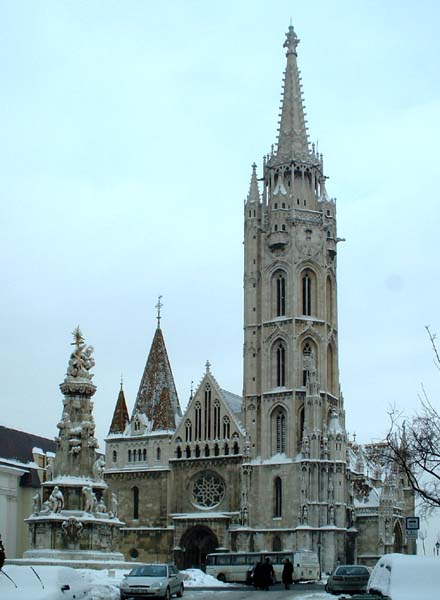Matthias Church

A Mátyás templom ( Nagyboldogasszony templom ) építése IV. Béla király idején kezdődött kora gótikus stílusban ( 1255-1269 ). Ebből a korból származik az északi torony. I. ( Nagy ) Lajos építtette a déli, Máriakaput, majd Zsigmond és a mindkét esküvőjét itt tartó Mátyás király bővíttette tovább a templomot a hollós címerével díszített déli toronnyal. Innen származik a gyakrabban használatos Mátyás templom elnevezés. A török időkben az épületet dzsámiként használták. Mai formáját a Schulek Frigyes irányításával végzett restauráláskor kapta ( 1874-1896 ). A templom freskói Székely Bertalan és Lotz Károly művei. A Loretói kápolnában áll a legendáktól övezett XVI. sz.-i márvány Madonna kegyszobor. A Szentháromság kápolnában III. Béla és felesége, Chatillon Anna 1848-ban Székesfehérváron megtalált csontjait helyezték el díszes szarkofágban ( 1862 ). Az altemplomban és a kápolnák feletti karzaton egyházművészeti múzeumi relikviák csodálhatók meg, köztük a Szent Korona pontos mása is. A kitűnő akusztikájú templomban a nagyszerű orgona hangversenyek gyakori szereplője.
A Mátyás templom előtt álló 14,4 méter magas Szentháromság szobrot ( 1713 Ugleich Fülöp - Hörger Antal ) az 1709. évi pestisjárvány emlékére állítottták fel, többször újrafaragták, uttoljára az 1960-as években. A szobornak helyet adó Szentháromság tér helyén a középkorban a Szent Miklós utca húzódott, az 1686-os ostromban azonban az itt álló házak elpusztultak.
Mátyás templom ( Matthias Church ) Originally this church was
called Our Lady of the Assumption, taking on its current name in the 19C
in homage to King Matthias Corvinus. He extended the edifice and celebrated
his first wedding here to Catherine of Podebrady, Princess of Bohemia,
and his second one to Beatrice, daughter of the king of Naples, Ferdinand
of Aragon. In the 13C King Béla IV had a triple-naved basilica built on
the site of the church dedicated to the Virgin. In 1309 Charles Robert
of Anjou was crowned king ( after being crowned in Székesfehérvár by the
bishop of Esztergom, according to the custom of the time ). The building
took on its current dimensions during the reigns of Sigismund of Luxemburg
( 14C ) and Matthias ( 15C ) who added the south tower. When the Turks
were masters of Buda in 1541, they completely destroyed the Christian furnishings,
transformed the church into a mosque, and covered the walls with carpets.
When the Christian armies liberated Our Lady in 1686, King Leopold I gave
it to the Jesuits, who endowed upon it Baroque elements. In 1867 the Emperor
of Austria, Franz-Josef I and his wife Elizabeth ( Sissy ) were crowned
as sovereigns of Hungary. Franz Liszt composed a Coronation Mass for the
occasion and conducted it himself. The king then decided to give the church
a Gothic appearance. An architect, Frigyes Schulek, was given responsibility
for the project which lasted for 20 years. Today the edifice has once more
regained its past splendour, and is one of the most visited places in the
capital.
Szentháromság szobor ( Trinity Column ) stands in the Szentháromság
tér ( Trinity Square ) in front of the Matthias Church. The main square
in the castle district. Trinity Column by Fülöp Ugleich and Antal Hörger
was raised in 1713 to commemorate the 17C and 18C plague epidemics. It
was the custom at the time for survivors to raise a monument to the glory
of God, to thank Him for sparing them. A great many towns have a similar
votive column.